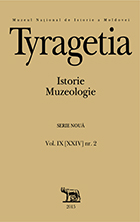Mazili şi ruptaşi ştiutori de carte din Basarabia în prima jumătate a secolului al XIX-lea
Literate mazili and ruptaşi in Bessarabia in the first half of the 19th century
Author(s): Valentin TomuleţSubject(s): History
Published by: Muzeul Naţional de Istorie a Moldovei
Keywords: Bessarabia; 19th century; mazili; ruptaşi
Summary/Abstract: Based on previously unpublished archival sources the author considers two privileged categories of the population of Bessarabia mazili and ruptaşi, attempting to show that some of them were literate and enjoyed respect and authority among the lower strata of the population. The number of literate mazili and ruptaşi possible, although quite difficult to identify by examination of the numerous petitions, complaints and claims addressed to county, regional and imperial institutions, especially in cases when after the fiscal censuses (1824, 1835, 1850, 1858) some of them for some reasons have not been identified in the social class of mazili or in the fiscal class of ruptaşi. Another similar situation was attested after the entry into force of the Law of 10 March 1847, under which mazili and ruptaşi from Bessarabia were reclassified to the Russian social category of odnodvortsy. Those, who for various reasons were not included in the list of the privileged classes of Bessarabia, had over the years to present documents proving that they belong to privileged social or fiscal categories. In addition to official documents signed by former rulers of Moldavia and the decisions of Provisional Committee of Bessarabia, mazili and ruptaşi were required to present testimonies of 24 persons from the category of ruptaşi and mazili, who could confirm under oath that the petitioners belong to mazili, ruptaşi or odnodvortsy. It is remarkable that the signatures on the testimonies argue that many of these ruptaşi and mazili were literate or at least were able to basically read and write. The signatures on these documents were made using Romanian Cyrillic alphabet, which means that after 1812 mazili and ruptaşi were taught to read and write at home.
Journal: Tyragetia (Serie Nouă)
- Issue Year: IX/2015
- Issue No: 2
- Page Range: 105-122
- Page Count: 18
- Language: Romanian

